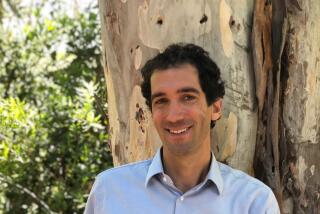The Tree of Life by Hugh Nissenson (Harper & Row: $15.95; 163 pp.)
- Share via
This small novel works like a laser beam, penetrating the American experience with searing and concentrated intensity. Hugh Nissenson has created a complete world--inhabitants, artifacts, dwellings, customs and behavior, always working with an archeologist’s precision. The place he has chosen is Richland County, Ohio, in the years from 1811 to 1845, when Ohio was where the frontier ended. His narrator is Thomas Keene, a New England widower attempting a fresh start in the western wilderness. Keene has left everything behind--his ministry, his religious faith, his surviving relatives; whatever worldly goods he may have once possessed. His present assets are the remnants of a classical education, a willingness to work at manual jobs, $17.62 in cash, one cow, one preserved calf’s stomach, a rifle, a copper still and a ledger in which he will write this diary. He owes the federal government $304 for his 160 acres, and until the land can be cleared and made productive, he plans to make his living by producing and selling whiskey, an anodyne for which there’s a great demand, though the settlement consists of only 26 souls, counting the women and children. Religion and strong drink are the only palliatives for the pain and misery of that harsh life. Having lost his belief in the first, Keene is dependent upon the second.
Long since tamed into gentle rolling plains and prosperous towns, Ohio at first seems a curious choice for this often brutal novel of survival. Only by a forcible wrench of imagination can we see it as it was almost 200 years ago--empty, terrifying; threatened from all sides by savages as ruthless as any mountain or desert tribe. Tecumseh had succeeded in firing the Delaware and Shawnee Indians with a ferocious zeal to regain their territory; raids against the settlers were frequent and bloody. Told entirely from Keene’s point of view and limited perspective, the narrative makes no concessions to revisionist history. Acts that the fair-minded would now consider outrages against humanity were regarded in quite another light by the settlers who watched the horrible deaths of their numbers at the hands of the Indians.
Life is short; death ever-present. A young man is bitten by a rattlesnake in the afternoon and the entire community knows his bride will be a widow by midnight. With strength, skill and luck, a few of the pioneers might have a chance at surviving an Indian massacre, but there’s no defense against cholera, pneumonia, or the various deadly fevers that attack them indiscriminately. Childbirth is perilous as war; one of five children might reach a first birthday. Some families lose all in a single epidemic. Keene’s diary doesn’t spare the ghastly details. They’re the sum and substance of the life Nissenson is reconstructing. The grimness of Keene’s own precarious existence is relieved by his love for Fanny, the widow of the man killed by the rattlesnake. He courts and marries her soon after her dead husband’s child is born; raising the baby girl as his own. Small financial transactions are meticulously recorded, mundane conversation reported with the same care given to Keene’s more philosophical discussions with John Chapman, the Johnny Appleseed of American legend. Every single act; brave or shameful, petty or crucial, private or public, is given its place in the author’s design. Keene tells us when he succumbs to weaknesses of the flesh and spirit; describes the state of his digestive system, offers his candid judgment of the other settlers; these humdrum incidents forming a continual counterpoint to the larger story of the making of America. Gradually, the wilderness is brought under control, the Indians routed, a fragile prosperity achieved. The author has illustrated the book with original line drawings and woodcuts, making our vision of Keene’s vanished world even more complete and explicit than the plain straightforward prose could do alone. “The Tree of Life” reverberates with a power far out of proportion to its modest length, cutting to the invisible roots of realism where all fiction begins.
More to Read
Sign up for our Book Club newsletter
Get the latest news, events and more from the Los Angeles Times Book Club, and help us get L.A. reading and talking.
You may occasionally receive promotional content from the Los Angeles Times.










